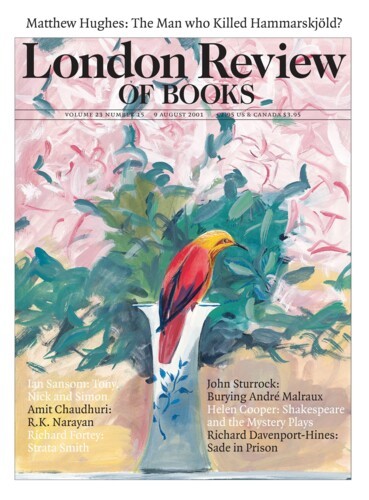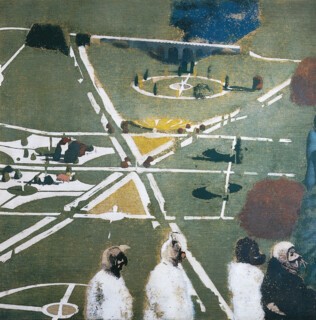Michael Andrews was born in 1928 and died in 1995. He didn’t produce many paintings (although the ones he made tended to be large). In the exhibition at Tate Britain until 17 October the full range of his work can be appreciated for the first time. Andrews followed a route which depersonalises the act of looking. He was taught by William Coldstream, and said: ‘Bill gave me my first enlightenment. He persuaded me of the paramount value of looking, of appraisal and, in transcription, of direct statement, of which he said: “Just write it down.” It was so simple and unforgettable.’ The little lines and crosses which show through the paint in Coldstream’s pictures record intervals meticulously (sometimes obsessionally and even destructively). In paintings by Sickert the grid which allowed a squared-up drawing to be copied to canvas sometimes shows through the paint. There are paintings by Andrews in which remnants of construction lines serve a double purpose: they are a necessary scaffolding, but also marks which demonstrate effort, in Andrews’s case that which has gone into transferring the details of an intermediate image – a postcard or photograph – to canvas. Like the hallmark on a piece of silver, they can work only if they interfere with the surface which they authenticate.
The use of photographs as a substitute for personal observation is a drastic distancing tactic, particularly when they are commercial images taken out of the context – newspapers and magazines – in which their usual meanings are generated. It was a move Sickert used: you can compare a row of painterly little portraits of pop stars by Andrews in this exhibition with Sickert’s picture (taken from a newspaper cutting) of Peggy Ashcroft in Venice, which is currently hanging in one of Tate Britain’s thematic displays. Andrews moved from this kind of reinterpretation of mechanical images to a Rauschenbergian use of over-painted screen-printed photographs and then to a much more meticulous copying of visual artefacts. Making his pictures of Ayers Rock in Australia in the 1980s, Andrews worked from collages of coloured photographs; another series was painted from photographs he had taken of himself deer-stalking in Scotland; a picture in which he is teaching his daughter to swim is based on a snapshot. Throughout his career he painted small portraits from life – they are not particularly distinguished, but convincingly modest, and provide a continuing test of another, direct, way of seeing.
In English painting, even recent painting, an autobiographical engagement with people and places is common. You find it in the work of Freud, Bacon and Spencer. Freud’s interrogation of the flesh, both intimate and unloving; Bacon’s use of imagery which takes its force from a willingness to do violence to the look of friends and lovers; Spencer’s exposure of private life and private parts in his search for intimate truths – are all typical of English uses of painting. Things seem to have been done differently in France. Matisse’s nudes are not also portraits, and Picasso’s women, even when they are recognisable, are depersonalised and turned into players in more general mythologies. Vuillard and Bonnard made pictures of the places they lived in and the people they lived with, but do not require one to guess at more than the picture shows. Although you can’t generalise – Leon Kossoff and Frank Auerbach make pictures of ordinary North London without seeming to imply stories about the scenes they record – there is an English tendency to find the first impetus to picture-making in personalities and narrative, rather than in formal values of tone, shape and colour. Even an abstract painter like Howard Hodgkin can assert that his pictures are rooted in particular experiences and represent significant moments. Sickert, and those English painters who tried to follow his lead, proved that painters might find their best opportunities in ordinary rooms, common streets and popular entertainments. The narrative element in Andrews’s pictures is unusually complicated. His early subjects are mundane and suburban (family in back garden, the beach, a dull block of flats); then there is the shabby glamour of Soho bohemia (The Colony Room). Stranger, invented, exotic parties follow (The Deer Park, All Night Long) peopled by figures taken from pictures in magazines. Then there is a group of mysterious scenes in which elongated figures, based on pictures of singers and stars, stand like ragged clothes-pegs in front of a modern building with palms and a pool which might be a resort hotel. These canvases are called Good and Bad at Games.
Seven pictures – Lights I to Lights VII – show seaside piers, a suspension bridge, traffic at night, a skyscraper at night and the shadow of a hot-air balloon. The balloon, shown or merely implied by the height from which the view is taken, links the images. They have a dream-like strangeness in which the contrast between the snap-shot facts and the aesthetic implication of big canvases and carefully applied flat paint plays a part. You see the balloon, you see from it, you see its shadow. That there is a meaning intended (a communicated emotion, a non-verbal comment on the nature of our relation to the real, seen world) is confirmed by accounts of Andrews’s thoughts about his work. In this case the idea is freedom: ‘to be released and unselfconscious – how wonderful that would be,’ Andrews noted on a scrap of paper. But he also believed that the verbal and visual could tangle negatively. In the exhibition catalogue,* William Feaver records an exchange from an interview with him: ‘There’s such a marvellous difference between ideas and imagery. I mean you can’t paint ideas; you really cannot paint ideas. Pictures which are based on ideas are the ones which founder.’
Andrews’s pictures are like disturbing dreams. It’s not just the intrusions – such as that of curious animal-masked figures in the foreground of views of the formal gardens of Drummond Castle. There is something grey, threatening and unexplained about his blandest landscapes. Ayres Rock is a discomfiting presence despite the bright desert light; the water in which he teaches his daughter to swim is threateningly black; in the stalking pictures it is the distant deer that first catch your eye, the prone figures who hunt them hunt you too. These effects are made stronger when you see the pictures together because Andrews employed no recognisable single way of making marks which would let you live, as it were, in the painter’s hand and eye. There is air-brushing, neat small-brush painting and, sometimes on the same canvas, there are broad painterly strokes – like the ones in A View from Uamh Mhor which describe the nearer hillsides. On that canvas and on Edinburgh (Old Town), streaks of thin paint drip down the picture over bare patches which look as though they are waiting to be finished (but which would resolve things altogether too much if they were). There are small studies close in appearance to Constable sketches. Sometimes the canvas is primed, sometimes bare brown linen shows through. His life’s work reads as a calculated attempt to avoid a style which would have a life of its own, and you finish up not knowing who, as a painter, he is.
There are some early photographs in the catalogue of Andrews with Soho friends like Lucian Freud and Tim Behrens (whose portrait is in the exhibition). Andrews was excited by parties: he looks at once charming and shy. Other painters of his generation impressed their personalities on their time by finding identifiable ways of making pictures. Andrews’s unrepetitive, very memorable series of images are the closest our times are likely to come to painterly anonymity.
Send Letters To:
The Editor
London Review of Books,
28 Little Russell Street
London, WC1A 2HN
letters@lrb.co.uk
Please include name, address, and a telephone number.


